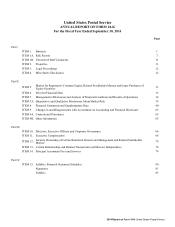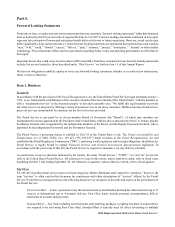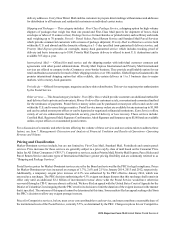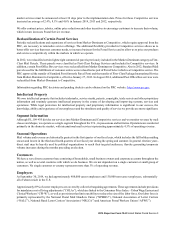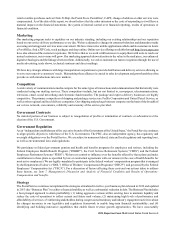US Postal Service 2014 Annual Report Download - page 12
Download and view the complete annual report
Please find page 12 of the 2014 US Postal Service annual report below. You can navigate through the pages in the report by either clicking on the pages listed below, or by using the keyword search tool below to find specific information within the annual report.
2014 Report on Form 10-K United States Postal Service 8
available under existing law and contractual arrangements will be sufficient to reduce the workforce or facilities to a level that
would allow a return to financial stability.
Our business and results of operations are significantly affected by competition from both competitors in the marketplace as
well as substitute products and channels provided by electronic communication services. If we do not compete effectively,
operate efficiently, grow marketing mail and package services and increase revenue and profit margins from other sources,
this adverse impact will become more substantial over time.
Our marketplace competitors primarily include providers of package delivery services. Our competitors have different cost
structures and fewer regulatory restrictions than we do and are able to offer differing services and pricing, which may hinder our
ability to remain competitive in these service areas. In addition, our competitors have access to public capital markets, which
allows them greater freedom in their investments and expansion of their business.
Customer usage of postal services continues to shift to substitute products and channels provided by electronic communication
services. Transactional mail, such as the presentment and payment of bills, has been eroded by competition from electronic
media, driven by some of our major mailers who actively promote the use of online services. The volume of Periodicals
continues to decline as people increasingly use electronic media for news and information. Periodical advertising has also
experienced a decline as a result of the move to a lower cost electronic media.
Existing laws and regulations limit our ability to introduce new products or services, enter new markets, generate new
revenue streams or manage our cost structure. These laws and regulations may also prevent us from increasing prices
sufficiently, or generating sufficient efficiency improvements, to offset increased costs. This would adversely affect our
results of operations.
In order to offset declining volume and revenue caused by the changing economy and electronic diversion, our ability to sell
new products and services in new or existing markets will be a key factor to our return to profitability. However, various laws
and regulations significantly limit our ability to enter new markets and/or to provide new services and products as defined by
traditional industry definitions. Without legal or regulatory changes that allow us to introduce new products or services to take
advantage of our assets, including our strong network and last-mile capabilities, we may be unable to respond adequately to
consumers’ changing needs and expectations. These limitations have the potential to adversely impact our results of operations
and long-term financial viability.
P.L. 109-435 generally limits price increases on our Market-Dominant services to the rate of inflation as measured by the CPI-
U. However, our costs are not similarly limited. A large portion of our cost structure cannot be altered expeditiously.
Accordingly, we may not be able to increase prices sufficiently to offset increased costs. Because our services are provided
primarily through our employees, our costs are heavily concentrated in wages and employee and retiree benefits. These costs are
significantly impacted by wage inflation, health benefit premium increases, retirement and workers’ compensation programs,
COLAs and the continuous growth of our delivery points. Some of these costs have historically tended to increase at a higher
rate than inflation as measured by the CPI-U. We believe that continuing productivity improvements alone will not be sufficient
to address the challenges presented by declining volume and revenue and the regulatory price cap, nor will revenue
enhancements keep pace with increased cost structures.
Slow market acceptance of new programs or product initiatives would adversely affect our results of operations.
We cannot be assured that recently launched programs or products, or any new programs or products that we may launch in the
future, will be accepted by our customers. We also cannot be certain that we will recover the costs we incurred in developing
any new programs or products or that our marketing efforts will be successful.
An unduly burdensome union contract arrived at either through negotiation or arbitration could have a significant adverse
impact on our future results of operations by impacting our control over wages and benefits and/or by limiting our ability to
manage our workforce effectively.
The majority of our labor force is represented by labor unions and covered by collective bargaining agreements, primarily with
the APWU, NALC, NPMHU and the NRLCA. The agreements currently in force include provisions for mandatory COLAs,
which are linked to the CPI-W. Although the increases in the CPI-W have been relatively low since its 2008 peak when it
conferred annual pay increases to employees of nearly $1.1 billion, a resurgence of consumer inflation could have a significant
adverse impact on our labor costs. The agreements also contain provisions that limit our ability to reduce the size of the labor
force. Reductions in the size and cost of our labor force are necessary to offset the effects of declining volume and revenue.



